Database indexes can make or break query performance, but choosing between clustered and non-clustered indexes often confuses developers and database administrators. Many assume that clustered indexes always perform better because they contain the actual data, while others believe non-clustered indexes are superior due to their flexibility. Performance benchmarks reveal that non-clustered indexes can outperform clustered indexes by up to 80% in specific scenarios, particularly for COUNT operations and queries requiring only a subset of columns.
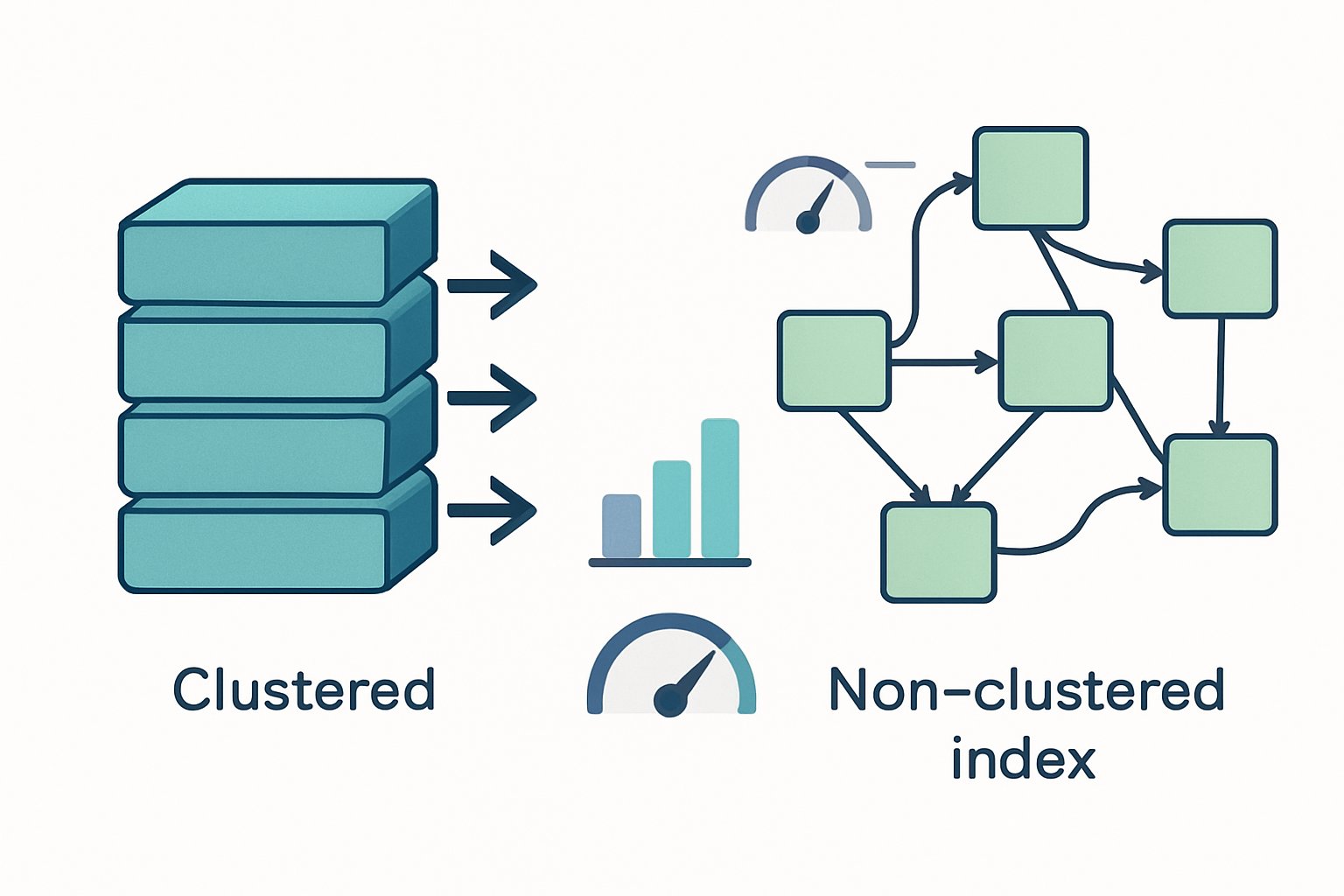
The reality is more complex than simple rules suggest. Performance testing shows that non-clustered indexes often outperform clustered indexes for operations like table scans because they require fewer page reads. A clustered index might need 1,982 page reads while a non-clustered index accomplishes the same task with just 414 reads.
Understanding when each index type excels requires examining real-world benchmarks across different database systems and query patterns. This analysis covers performance comparisons between SQL Server and PostgreSQL, maintenance overhead considerations, and practical scenarios where each index type delivers optimal results. The data reveals surprising patterns that challenge common assumptions about database indexing strategies.
Key Takeaways
- Non-clustered indexes can deliver significantly better performance than clustered indexes for specific query types and data access patterns
- Index selection should be based on actual performance testing rather than assumptions about which type is inherently superior
- Proper index maintenance and understanding query patterns are more important than simply choosing between clustered or non-clustered approaches
Understanding Clustered Indexes
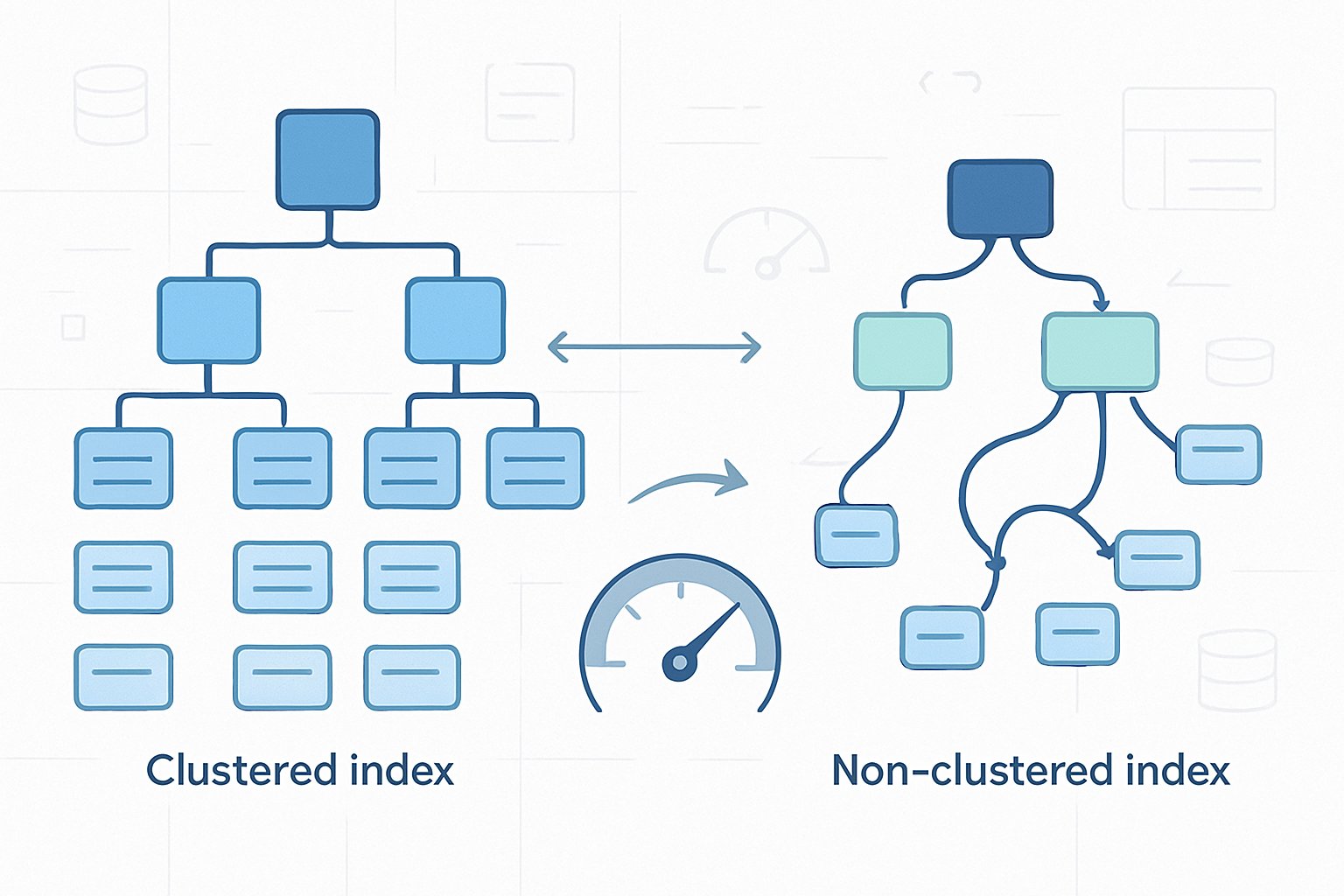
A clustered index physically sorts table data on disk based on the index key values, making it fundamentally different from other index types. The primary key automatically becomes the clustered index in most database systems, directly impacting how data gets stored and retrieved.
Physical Order of Data Rows
Clustered indexes define how table data gets physically stored on disk. The database engine rearranges actual data rows to match the sort order of the clustered index key.
When a table has a clustered index on the customer ID column, all customer records get physically ordered by ID number. Customer 1 appears before Customer 2, which appears before Customer 3 on the storage device.
This physical ordering creates a direct relationship between the index structure and data storage. Each table can only have one clustered index because data rows can only exist in one physical order.
The database stores data pages in a linked sequence. Adjacent pages contain logically related data based on the clustered index key values.
Role of Primary Key in Clustered Index
SQL Server automatically creates a clustered index on the primary key column unless specified otherwise. The primary key constraint and clustered index work together to ensure data uniqueness and physical ordering.
Primary keys make ideal clustered index candidates because they are unique and often used in queries. The database engine uses primary key values to determine where new rows get physically inserted.
When developers define a primary key without specifying an index type, the system creates a clustered index by default. This behavior applies to most relational database management systems.
Tables without primary keys can still have clustered indexes on other columns. However, the chosen column should contain unique or mostly unique values for optimal performance.
Benefits and Limitations
Clustered indexes provide significant performance advantages for range queries and sorted data retrieval. Sequential scans become extremely fast because related data sits physically adjacent on disk.
Benefits include:
- Faster range scans and sorting operations
- Reduced I/O for sequential data access
- Optimal performance for queries using the clustered key
Limitations include:
- Expensive insert and update operations when data arrives out of order
- Page splits occur when new data doesn’t fit in the correct physical location
- Only one clustered index allowed per table
Insert operations can trigger page splits when new rows need to maintain physical order. This overhead makes clustered indexes less suitable for tables with frequent random inserts.
Exploring Non-Clustered Indexes
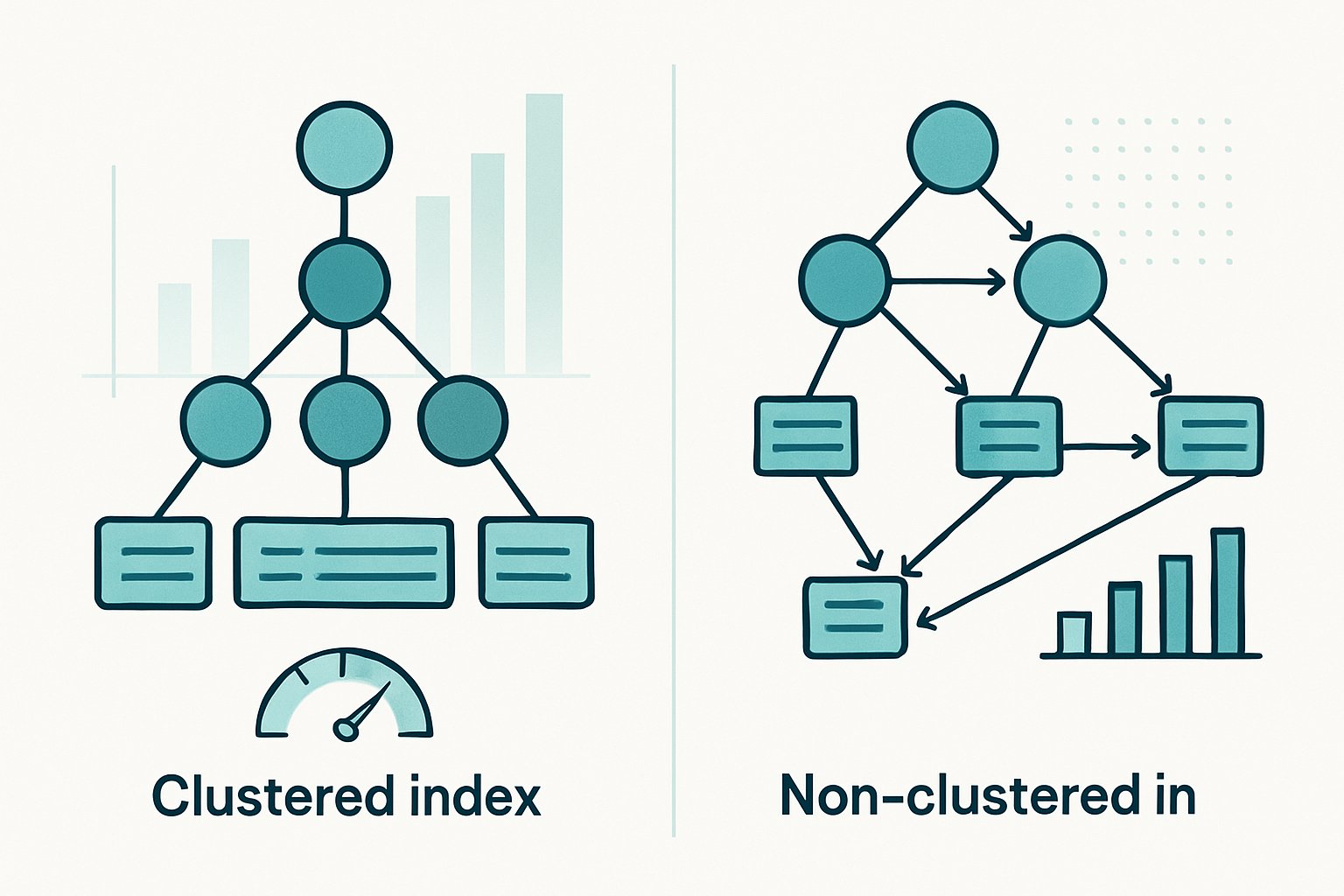
Non-clustered indexes function as separate data structures that point to actual table rows rather than physically reorganizing data. They allow multiple indexes per table and can serve as covering indexes when they contain all required query columns.
Structure of Non-Clustered Index
Non-clustered indexes create a sorted copy of indexed columns along with pointers to corresponding table rows. This structure resembles an index at the back of a book that lists keywords and page numbers.
The database engine first searches the non-clustered index for required values. It then uses the pointers to retrieve the corresponding rows from the data table.
Key Components:
- Index pages: Store sorted key values
- Leaf level: Contains index keys and row locators
- Row locators: Point to clustered index keys or heap RIDs
SQL Server searches the non-clustered index first. If additional columns are needed, it performs a key lookup to fetch the full row data.
This two-step process makes non-clustered indexes slower than clustered indexes for queries requiring columns not included in the index.
Multiple Indexes per Table
Tables can have multiple non-clustered indexes, unlike clustered indexes which are limited to one per table. A student table with a primary key on roll number automatically creates a clustered index.
Database administrators can create additional non-clustered indexes on frequently queried columns like Name, Department, or Email. Each index operates independently and serves different query patterns.
Common scenarios for multiple indexes:
- Search queries: Index on lastname, firstname
- Filter operations: Index on status, category
- Date ranges: Index on created_date, modified_date
Non-clustered indexes can use the same key columns but in different order. They can also have different ASC/DESC settings on columns to support alternate presentation orders.
Each additional index requires maintenance overhead during INSERT, UPDATE, and DELETE operations.
Covering Index Explained
A covering index contains all columns needed to satisfy a query without accessing the base table. This eliminates the need for key lookups and significantly improves query performance.
Example covering index:
CREATE INDEX IX_Employee_Covering
ON Employees (Department, LastName)
INCLUDE (FirstName, Salary, HireDate)
This index covers queries that filter by Department and LastName while selecting FirstName, Salary, and HireDate. The query engine can retrieve all required data directly from the index pages.
Benefits of covering indexes:
- Eliminates key lookup operations
- Reduces I/O operations
- Improves query execution time
- Decreases resource consumption
Covering indexes work best for frequently executed queries with predictable column requirements. They require more storage space but provide substantial performance gains for covered queries.
Core Differences Between Clustered and Non-Clustered Indexes
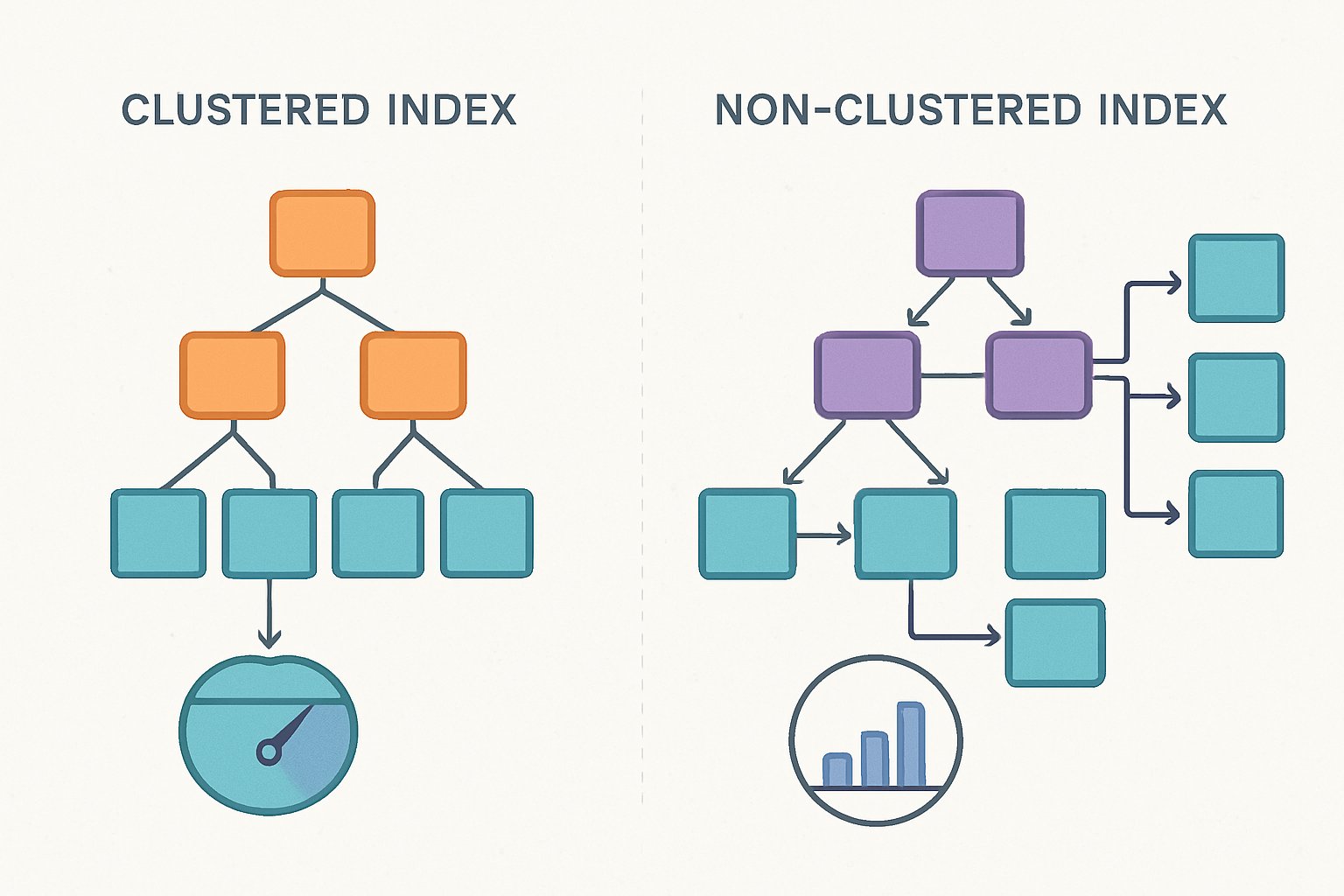
Clustered indexes physically reorder table data on disk, while non-clustered indexes create separate lookup structures. These fundamental differences between clustered and non-clustered indexes directly impact storage methods, query speeds, and database design flexibility.
Physical vs Logical Data Structure
Clustered indexes control how data gets stored physically on disk. The database rearranges entire table rows to match the sort order of the index key. This means all table data lives in one organized structure.
Only one clustered index can exist per table. The data itself can only be sorted one way physically. When developers insert new rows, the database must maintain this physical order.
Non-clustered indexes work differently. They create separate lookup tables that contain pointers to the actual data rows. The original table data stays in its current location unchanged.
Tables can have multiple non-clustered indexes. Each index sorts different columns without moving the underlying data. This approach uses more storage space but offers greater flexibility.
| Index Type | Data Storage | Table Limit | Storage Impact |
|---|---|---|---|
| Clustered | Physical reordering | 1 per table | Lower overhead |
| Non-clustered | Separate pointers | Multiple allowed | Higher overhead |
Indexing and Query Performance
Clustered indexes excel at range queries and table scans. Since related data sits together physically, the database reads consecutive pages efficiently. Query performance improves significantly when searching for data ranges.
Large datasets benefit most from clustered indexes during sequential access. The database avoids jumping between different disk locations. Write operations can be slower due to page splits when maintaining order.
Non-clustered indexes perform better for exact lookups and point queries. They require an extra step to follow pointers from index to actual data. This lookup penalty grows with larger result sets.
Query performance varies based on access patterns:
- Range scans: Clustered indexes win
- Single row lookups: Non-clustered indexes competitive
- Multiple column searches: Non-clustered indexes more flexible
Flexibility and Scalability
Non-clustered indexes provide superior flexibility for complex database designs. Developers can create indexes on any combination of columns without affecting data storage. This supports diverse query patterns effectively.
Large datasets require careful index planning. Clustered indexes work well when most queries filter on the same columns. Non-clustered indexes handle varied access patterns better but consume more memory and storage.
Scalability considerations differ between index types. Clustered indexes maintain better performance as tables grow due to physical locality. Non-clustered indexes face increasing lookup costs but offer more tuning options.
Database administrators often combine both approaches. They use clustered indexes for primary access patterns and add non-clustered indexes for specific query needs. This hybrid strategy maximizes both performance and flexibility.
Performance Benchmarks and Real-World Scenarios
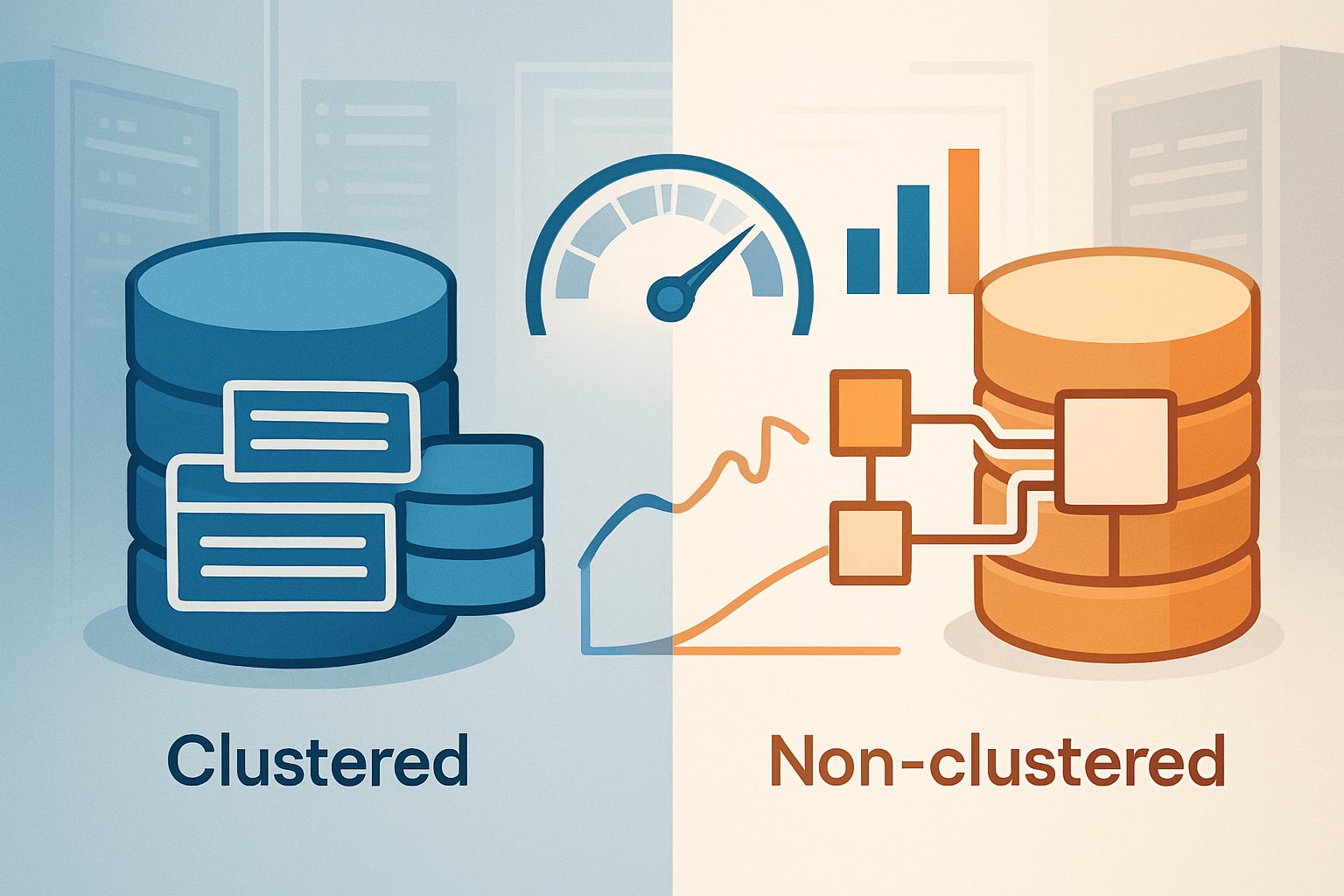
Performance tests show clear differences between clustered and non-clustered indexes across various database operations. Query speed varies significantly based on data size, while read and write operations show distinct patterns that impact overall database performance.
Query Speed Comparisons
Non-clustered indexes can outperform clustered indexes in specific scenarios, particularly for COUNT operations. Tests on the Warehouse.StockItemTransactions table revealed dramatic differences in page reads.
The non-clustered index required only 414 page reads compared to 1,982 reads for the clustered index. This represents a 79% reduction in I/O operations for the same query.
Query Performance Results:
| Index Type | Page Reads | Duration | I/O Cost |
|---|---|---|---|
| Non-clustered | 414 | Lower | Minimal |
| Clustered | 1,982 | Higher | Significant |
Range scans and singleton seeks also benefit from skinnier non-clustered indexes. The reduced page count directly translates to faster query execution times.
Memory-constrained systems see even greater performance gaps. The difference becomes more pronounced with larger datasets and slower storage systems.
Read vs Write Efficiencies
Read operations favor non-clustered indexes when queries require fewer columns. The smaller index size reduces memory consumption and speeds up data retrieval.
Write operations tell a different story. Every INSERT, UPDATE, or DELETE must maintain all indexes on the table. Additional non-clustered indexes increase maintenance overhead significantly.
Write Operation Impact:
- Each new index adds storage requirements
- Memory usage increases with index count
- Transaction log grows larger with multiple index updates
Tables with high write volumes should minimize non-clustered indexes. Read-heavy workloads can justify the extra maintenance cost for improved query speed.
The trade-off becomes critical in OLTP systems where write performance directly affects user experience.
Impact on Large Datasets
Large datasets amplify the performance differences between index types. Tables with millions of rows show the most dramatic variations in query performance.
Clustered indexes on large tables consume significantly more storage space. The physical row data increases the total pages that queries must scan.
Non-clustered indexes remain compact regardless of table size. They store only key columns plus row locators, maintaining consistent performance as data grows.
Large Dataset Considerations:
- Page reads scale linearly with clustered index size
- Non-clustered indexes maintain stable I/O patterns
- Memory pressure increases with larger clustered scans
Database systems under memory pressure benefit most from targeted non-clustered indexes. The reduced memory footprint allows more index pages to remain cached.
Performance monitoring becomes essential as datasets grow beyond available memory. Query plans may shift between index types based on current system resources.
Index Usage and Query Patterns
Database engines select different index types based on specific query patterns and data access requirements. Query access patterns determine whether clustered indexes excel for range scans or non-clustered indexes perform better for point lookups.
Optimizing Query Performance
Database administrators must match index types to filter requirements for optimal results. Clustered indexes work best for queries that retrieve multiple consecutive rows.
Range queries benefit significantly from clustered indexes. When searching for dates between specific values, the database reads adjacent pages efficiently.
Non-clustered indexes excel at exact value lookups. Single record retrievals using primary keys or unique identifiers perform faster with non-clustered structures.
Query Type Performance:
- Range scans: Clustered indexes reduce I/O operations
- Point lookups: Non-clustered indexes minimize overhead
- Sort operations: Clustered indexes eliminate additional sorting steps
Join operations require careful index planning. Foreign key columns often benefit from non-clustered indexes to speed up table relationships.
Full Table Scan vs Index Seek
Query engines choose between full table scans and index seeks based on data selectivity. Small result sets typically trigger index seeks for better performance.
Full table scans occur when queries return large portions of table data. The database engine determines that reading all pages sequentially costs less than following index pointers.
Index seeks happen when queries filter data using indexed columns. The database navigates directly to relevant rows without examining unnecessary data.
Scan vs Seek Factors:
- Result set size: Large results favor table scans
- Index selectivity: High selectivity triggers seeks
- Memory availability: Sufficient RAM improves scan performance
Query execution plans reveal whether operations use index seeks or table scans. Developers analyze these plans to identify optimization opportunities.
Choosing Indexes for Common Patterns
Different application patterns require specific indexing strategies. E-commerce platforms need indexes on product categories and price ranges for catalog searches.
Common Index Patterns:
- Primary keys: Clustered indexes for unique identification
- Foreign keys: Non-clustered indexes for join performance
- Date ranges: Clustered indexes for chronological data
- Status fields: Non-clustered indexes for filtering
Tables support multiple non-clustered indexes but only one clustered index. This limitation requires careful selection of the clustered key.
Search functionality benefits from non-clustered indexes on text columns. Customer name searches perform faster with dedicated index structures.
Reporting queries often scan large date ranges. Clustered indexes on timestamp columns enable efficient sequential access for analytics workloads.
Index Maintenance and Best Practices
Proper index maintenance requires regular monitoring, careful management of storage overhead, and strategic decisions about which indexes to keep. Index maintenance methods like reorganizing and rebuilding directly impact query performance and resource consumption.
Monitoring and Tuning Indexes
Database administrators need to track index usage patterns to identify performance bottlenecks. SQL Server provides Dynamic Management Views (DMVs) that reveal which indexes get used most frequently.
The sys.dm_db_index_usage_stats DMV shows seek, scan, and lookup operations for each index. This data helps administrators understand which indexes contribute to database performance and which ones consume resources without providing value.
Index fragmentation occurs when data pages become scattered across storage. Fragmented indexes require more I/O operations to retrieve data, slowing down queries.
Administrators should check fragmentation levels regularly using these thresholds:
- 0-10%: No action needed
- 10-30%: Reorganize the index
- 30%+: Rebuild the index
Page density affects storage efficiency and query speed. Low page density means wasted space and more pages to read during scans.
Managing Index Overhead
Every index requires additional storage space and maintenance during data modifications. Insert, update, and delete operations must touch all relevant indexes, not just the base table.
Clustered indexes typically require less maintenance overhead than multiple non-clustered indexes. They store data pages in logical order, reducing fragmentation from normal insert patterns.
Non-clustered indexes need more frequent maintenance, especially when the underlying data changes frequently. Each non-clustered index adds overhead to write operations.
Storage considerations include:
- Index size relative to table size
- Available disk space for rebuilding
- Memory requirements for maintenance operations
Database administrators should schedule index maintenance during low-activity periods. Rebuilding large indexes can block other operations and consume significant system resources.
Avoiding Redundant Indexes
Performance testing shows that redundant non-clustered indexes can sometimes outperform clustered indexes for specific queries, but most duplicate indexes waste resources.
Truly redundant indexes share the same key columns in the same order with identical included columns. These provide no performance benefit while doubling maintenance costs.
Partially redundant indexes might serve different purposes despite sharing some columns. An index on (LastName, FirstName) serves different queries than one on (FirstName, LastName).
Database administrators can identify unused indexes through sys.dm_db_index_usage_stats to find candidates for removal. Indexes with zero or very low usage statistics often represent unnecessary overhead.
Filtered indexes can replace broader indexes for specific query patterns. They cover fewer rows, require less storage, and need less maintenance than full table indexes.
Comparing SQL Server and PostgreSQL Indexing Approaches
SQL Server uses clustered indexes to physically order table data, while PostgreSQL stores all tables as unordered heaps with purely logical indexes. PostgreSQL’s B-Tree deduplication can reduce index size by 3x compared to SQL Server when handling repeated values.
Platform-Specific Index Behavior
SQL Server implements clustered indexes that physically order table data by the indexed column. This creates a tight coupling between the index and physical storage layout. Tables can only have one clustered index, which stores rows in the same order as the index itself.
Non-clustered indexes in SQL Server store separately and point to rows using row locators. Each index entry stores in full, even when multiple entries contain identical values on the same page.
PostgreSQL takes a different approach entirely. PostgreSQL does not have clustered indexes in the SQL Server sense. All tables exist as unordered heaps with indexes serving as purely logical structures.
PostgreSQL introduced B-Tree deduplication in version 13. This feature stores repeated values once per index page while maintaining compact structures for all matching heap pointers. The system reduces index bloat significantly for columns with many duplicate values.
Vendor Support and Tools
Microsoft provides extensive built-in tools for SQL Server index management. The Database Engine Tuning Advisor automatically recommends index optimizations based on workload analysis. SQL Server Management Studio offers graphical interfaces for index creation and maintenance.
Microsoft’s Azure SQL extends these capabilities with intelligent performance recommendations. The platform automatically identifies missing indexes and suggests optimization strategies.
PostgreSQL relies heavily on community-driven tools and extensions. pganalyze Index Advisor automatically detects missing and redundant indexes using constraint programming models against real query data.
Open-source extensions like PostGIS add spatial indexing capabilities. The pgvector extension enables vector indexing for machine learning applications. PostgreSQL’s extensible architecture allows developers to create custom index types for specialized use cases.
Frequently Asked Questions
Performance differences between clustered and non-clustered indexes depend on query type and data retrieval patterns. Clustered indexes excel at range queries and full row retrieval, while non-clustered indexes perform better for specific column selections and counting operations.
What are the performance differences between clustered and non-clustered indexes in SQL Server?
Clustered indexes organize the entire table data physically based on the index key. This makes them faster for retrieving complete rows and performing range queries on the indexed columns.
Non-clustered indexes store pointers to table rows separately from the actual data. They perform better when queries only need columns included in the index itself.
Non-clustered indexes can outperform clustered indexes for operations like row counting and queries that are entirely covered by the index columns. However, they require additional disk space and maintenance overhead.
Write operations typically perform faster with fewer indexes. Each additional non-clustered index increases the time needed for inserts, updates, and deletes.
How do clustered indexes affect query speed compared to non-clustered indexes?
Clustered indexes provide faster access when queries retrieve entire rows or perform range scans. The data is already organized in the correct order, eliminating the need for additional lookups.
Non-clustered indexes can be faster for queries that only need specific columns. When all required columns exist in the index, the database engine doesn’t need to access the main table data.
Clustered indexes determine the physical storage order of table data. This makes sequential reads and ordered results more efficient for the indexed columns.
Query performance also depends on selectivity. Highly selective queries benefit more from non-clustered indexes, while broader queries often perform better with clustered indexes.
When should a clustered index be used over a non-clustered index in a database?
Clustered indexes work best for columns frequently used in range queries or ORDER BY clauses. Primary key columns are ideal candidates since they typically have unique, sequential values.
Tables with frequent full-row retrievals benefit from clustered indexes. When applications need most or all columns from matching rows, clustered indexes eliminate extra lookup steps.
Only one clustered index per table is allowed because data can only be physically ordered one way. Choose the most frequently queried column combination for optimal performance.
Avoid clustered indexes on frequently updated columns. Changes to clustered index keys require moving entire rows, which impacts write performance significantly.
Can you provide an example of a non-clustered index and its impact on performance?
A customer table with a non-clustered index on the email column allows fast lookups by email address. The index contains email values and pointers to the corresponding table rows.
When searching for a customer by email, the database first searches the smaller index structure. It then follows the pointer to retrieve the complete customer record from the main table.
Non-clustered indexes work like book indexes, providing quick access to specific information without scanning the entire content. This dramatically reduces query time for targeted searches.
Performance improvement depends on table size and query selectivity. Larger tables with selective queries see the most significant speed improvements from non-clustered indexes.
How do primary indexes compare to clustered indexes in terms of retrieval speed?
Primary key constraints automatically create clustered indexes in most database systems. This makes primary key lookups extremely fast since the data is physically organized by these values.
Primary indexes provide the fastest single-row retrieval when searching by the primary key value. The database can navigate directly to the correct data page without additional lookups.
Retrieval speed depends on the primary key design. Sequential integer keys typically perform better than random values like GUIDs for range queries and insertions.
Composite primary keys may have slower retrieval speeds than single-column keys. The database must evaluate multiple columns to locate the correct row position.
In what scenarios are clustered and non-clustered indexes implemented in PostgreSQL for optimal performance?
PostgreSQL uses clustered indexes for tables with frequent range queries on date or timestamp columns. Order processing systems benefit from clustering on order_date or created_at fields.
Non-clustered indexes work well for foreign key columns in PostgreSQL. Product catalogs use non-clustered indexes on category_id to speed up filtered product listings.
PostgreSQL allows multiple indexing strategies to be combined for optimal query performance. Complex applications often use both index types on different column combinations.
Reporting queries benefit from clustered indexes on frequently grouped or sorted columns. Analytical workloads perform better when data is pre-organized by common aggregation fields.




